The Property
This wonderful property is presented to an exceptional standard and provides around 4,000 sq. ft. of luxurious space, enclosed within distinctive architectural styling.
McCarthy Holden are renowned for producing high end video productions for special properties in and around Finchampstead Ridges near Wellington College, so it’s no surprise that this beautiful property got that special added marketing bonus.
There is hundreds of acres of National Trust land on the doorstep of this property, providing access to wonderful woodland walks nearby, yet this location benefits from ease of access to London, Heathrow and the M3 / M4 motorways, and of course towns such as Wokingham, Reading, Bracknell and Basingstoke.
Ground Floor
The impressive reception hall sets the scene for exploring this luxury property, with high specification indicators such as the French polished internal oak doors, skirtings, architraves and a bespoke oak staircase, French polished with handmade architectural metal balustrade.
Additional ground floor accommodation includes a significant kitchen/family/dining room, a fine living room, a dining room, sitting/tv family room, study, a substantial gym room, cloakroom and a utility room.
The Optiplan kitchen is complemented by a granite work surface, natural stone flooring and under cupboard and plinth lighting. Features and appliances include three Villeroy and Boch white ceramic sinks, a Rangemaster Cooker with Extractor Hood, Samsung USA style Fridge/Freezer with ice and water, a Bosch fully integrated dishwasher and a Caple built in wine cooler. Best of all the stunning kitchen opens directly into a wonderful breakfast garden room with vaulted ceiling and the benefit of views over the grounds to the rear.
First Floor
On the first floor there is an impressive landing. There are five bedrooms, three with an en-suite.
The vast master bedroom suite benefits from a fine range of built in bedroom furniture with soft close doors with French polished wood finish. The luxurious en-suite bathroom and shower room features a distinctive Edwardian style bath tub, a shower cubicle, a wc, bidet and pedestal wash basin. The property benefits from heating by way of a gas fired condensing Worcester Bosch boiler, with radiators.
Grounds
To the front of the property there is a sweeping driveway with two electronic gated entry / exit stations. To the rear of the property there is a vast natural stone patio leading to tree fringed formal gardens.
Location
The property is located about 5 miles to the South West of the charming market town of Wokingham. There is excellent schooling in the area including Holme Grange, Luckley House, Yateley Manor St Neots,, and Wellington College which is less than a mile away, Heathrow Airport is about 35 miles and Farnborough Airport is about 11 miles distant. Private aircraft facilities are also available at Blackbushe Airport (about 6 miles).
Contact our Hartley Wintney branch / Telephone 01252 842100 for further details.


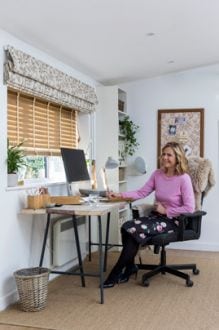 A calm and stylish space can boost productivity and look good, as entrepreneur Liz Earle tells Gabrielle Fagan.
Millions of us now spending some, if not all, of our time working from home. And one of the joys of working in your own space is that you’re the boss when it comes to design and ambience – so you can escape dull desks and bland decor and kit out your own personalised sanctuary to suit your taste.
Entrepreneur and beauty and wellbeing expert, Liz Earle, has teamed up with blinds and curtain specialist Hillarys (hillarys.co.uk), to reveal her own home office and simple but effective tips to help you conjure a stylish work area of your own, where you can be happy as well as productive.
“It’s a quick and easy strategy for creating the perfect space, or could be used for an existing office makeover, which could be just what you need to reinvigorate your home-working life,” enthuses mother-of-five Earle, 54, who lives on a farm in the West Country. “There’s undoubtedly a whole host of benefits to home-working, particularly from a health and wellbeing perspective, whether that’s because you’re escaping the daily commute or because you’re able to spend more time with the family.”
Read on to discover Earle’s approach for creating a calm and stylish home office…
1. Work with the light
“Put your desk in front of a window; plenty of natural light is the holy grail, as it’s known to significantly help increase energy, creativity and productivity,” advises Earle. “Wood or faux wood Venetian blinds are perfect for home office windows as they filter light, which will minimise glare on a computer screen and the slats can be adjusted to control light levels when the sun moves round during the day. Go for function but don’t forget about style. Roman blinds soften the look, and a pretty botanical fabric brings a lovely feel of nature into the room.”
A calm and stylish space can boost productivity and look good, as entrepreneur Liz Earle tells Gabrielle Fagan.
Millions of us now spending some, if not all, of our time working from home. And one of the joys of working in your own space is that you’re the boss when it comes to design and ambience – so you can escape dull desks and bland decor and kit out your own personalised sanctuary to suit your taste.
Entrepreneur and beauty and wellbeing expert, Liz Earle, has teamed up with blinds and curtain specialist Hillarys (hillarys.co.uk), to reveal her own home office and simple but effective tips to help you conjure a stylish work area of your own, where you can be happy as well as productive.
“It’s a quick and easy strategy for creating the perfect space, or could be used for an existing office makeover, which could be just what you need to reinvigorate your home-working life,” enthuses mother-of-five Earle, 54, who lives on a farm in the West Country. “There’s undoubtedly a whole host of benefits to home-working, particularly from a health and wellbeing perspective, whether that’s because you’re escaping the daily commute or because you’re able to spend more time with the family.”
Read on to discover Earle’s approach for creating a calm and stylish home office…
1. Work with the light
“Put your desk in front of a window; plenty of natural light is the holy grail, as it’s known to significantly help increase energy, creativity and productivity,” advises Earle. “Wood or faux wood Venetian blinds are perfect for home office windows as they filter light, which will minimise glare on a computer screen and the slats can be adjusted to control light levels when the sun moves round during the day. Go for function but don’t forget about style. Roman blinds soften the look, and a pretty botanical fabric brings a lovely feel of nature into the room.”
 2. Make an eco desk choice
“Make your office more eco-friendly with a desk made from reclaimed scaffolding boards and simple trestle legs,” Earle suggests. “Scaffolding boards can be picked up cheaply from a salvage yard, and the beauty of doing this is that you can design your desk according to your space and needs. Make sure there’s room for a task light and desk accessories.”
3. Invest in a great chair
“As tempting as it sounds, dragging a chair from the dining room or a stool from the kitchen is a false economy,” Earle warns. “An ergonomically designed chair may not give you the designer feel you had in mind – but your back will thank you for it! You can always pretty it up with a cosy sheepskin or throw.
“Don’t hunch over a laptop – set up a computer monitor at eye level and use a separate keyboard, ergonomic mouse or track pad. Rest forearms on the desk while typing and invest in a simple foot rest to ensure you sit with legs at a comfortable 90-degree angle to the floor.”
TIP: Try to do simple stretches and strength moves regularly throughout the day. You don’t necessarily need equipment – try out chair yoga which can be done while seated.
4. Get crafty with accessories
“It needn’t cost the earth to decorate your office. Charity shops and car-boot sales are perfect hunting grounds for quirky, vintage pieces, or you could indulge in some DIY creativity,” says Earle. “Cover plain cardboard box files with wallpaper or fabric for a fabulous bespoke look. A pin-board, made from a wooden picture frame, foam and fabric, is a great way to display photos, to-do lists or other information you want to see at a glance.”
TIP: Schedule things in your diary that make you happy, not just work tasks.
5. Bring nature into your space
“It’s been proven that plants in the workplace can reduce stress levels and increase productivity,” Earle points out. “Aside from these health benefits, plants are a cheap and cheerful way to add decoration and bring the outdoors in. I opt for green, leafy plants like ferns or ivy, avoiding cacti whose spikes can create the opposite of a relaxed feeling, or flowers with a strong scent, which can be distracting or irritating.” And if caring for real plants doesn’t quite work out for you, there are great faux options available these days, so you can still get that calming, leafy look.
2. Make an eco desk choice
“Make your office more eco-friendly with a desk made from reclaimed scaffolding boards and simple trestle legs,” Earle suggests. “Scaffolding boards can be picked up cheaply from a salvage yard, and the beauty of doing this is that you can design your desk according to your space and needs. Make sure there’s room for a task light and desk accessories.”
3. Invest in a great chair
“As tempting as it sounds, dragging a chair from the dining room or a stool from the kitchen is a false economy,” Earle warns. “An ergonomically designed chair may not give you the designer feel you had in mind – but your back will thank you for it! You can always pretty it up with a cosy sheepskin or throw.
“Don’t hunch over a laptop – set up a computer monitor at eye level and use a separate keyboard, ergonomic mouse or track pad. Rest forearms on the desk while typing and invest in a simple foot rest to ensure you sit with legs at a comfortable 90-degree angle to the floor.”
TIP: Try to do simple stretches and strength moves regularly throughout the day. You don’t necessarily need equipment – try out chair yoga which can be done while seated.
4. Get crafty with accessories
“It needn’t cost the earth to decorate your office. Charity shops and car-boot sales are perfect hunting grounds for quirky, vintage pieces, or you could indulge in some DIY creativity,” says Earle. “Cover plain cardboard box files with wallpaper or fabric for a fabulous bespoke look. A pin-board, made from a wooden picture frame, foam and fabric, is a great way to display photos, to-do lists or other information you want to see at a glance.”
TIP: Schedule things in your diary that make you happy, not just work tasks.
5. Bring nature into your space
“It’s been proven that plants in the workplace can reduce stress levels and increase productivity,” Earle points out. “Aside from these health benefits, plants are a cheap and cheerful way to add decoration and bring the outdoors in. I opt for green, leafy plants like ferns or ivy, avoiding cacti whose spikes can create the opposite of a relaxed feeling, or flowers with a strong scent, which can be distracting or irritating.” And if caring for real plants doesn’t quite work out for you, there are great faux options available these days, so you can still get that calming, leafy look.
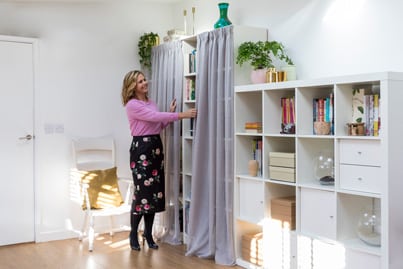 6. Conceal the clutter
“But remember, the more stuff you add to your desk, the more your brain has to keep track of,” adds Earle. “Working in a crowded space can be mentally exhausting and distracting, even if you don’t realise it. Get creative with storage. I’ve used soft, floaty voile curtains to disguise a shelving unit.”
7. Create an uplifting display
Finally, treasured photos that spark joy, and meaningful sayings to keep motivation levels up, make an ideal finishing touch. “Pictures and photographs can be a great way to inspire creativity and a feeling of wellness,” says Earle. “Pick out three or four that are significant to you and make sure those are in your view.”
Conclusion
Whether
6. Conceal the clutter
“But remember, the more stuff you add to your desk, the more your brain has to keep track of,” adds Earle. “Working in a crowded space can be mentally exhausting and distracting, even if you don’t realise it. Get creative with storage. I’ve used soft, floaty voile curtains to disguise a shelving unit.”
7. Create an uplifting display
Finally, treasured photos that spark joy, and meaningful sayings to keep motivation levels up, make an ideal finishing touch. “Pictures and photographs can be a great way to inspire creativity and a feeling of wellness,” says Earle. “Pick out three or four that are significant to you and make sure those are in your view.”
Conclusion
Whether 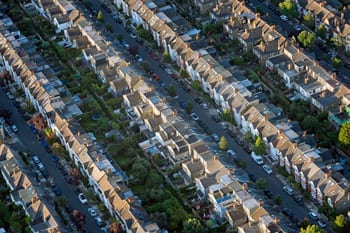 London Tops The Tables
London Tops The Tables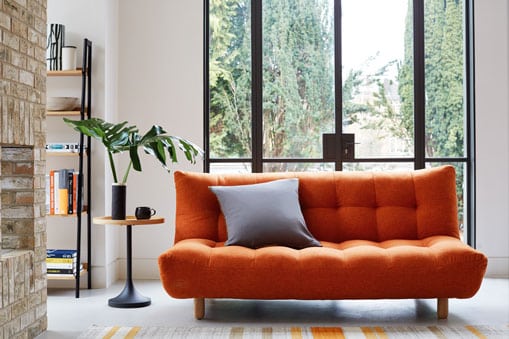
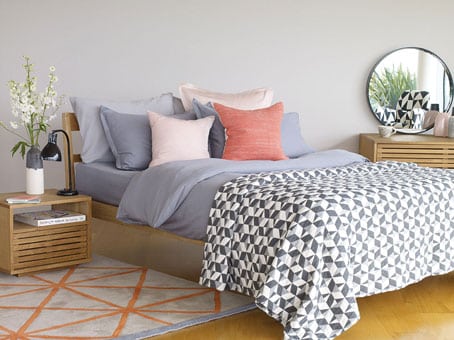
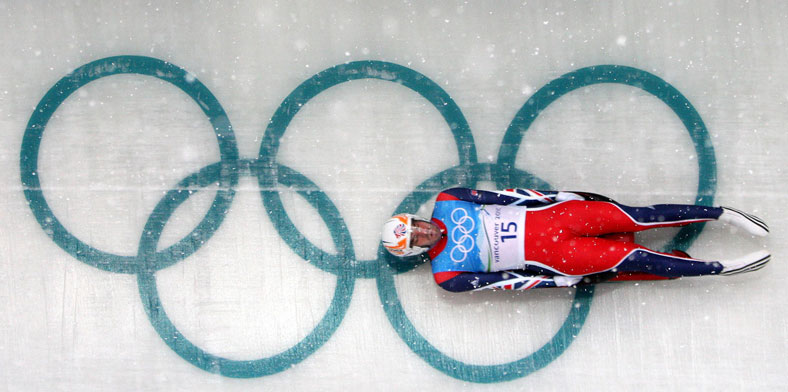
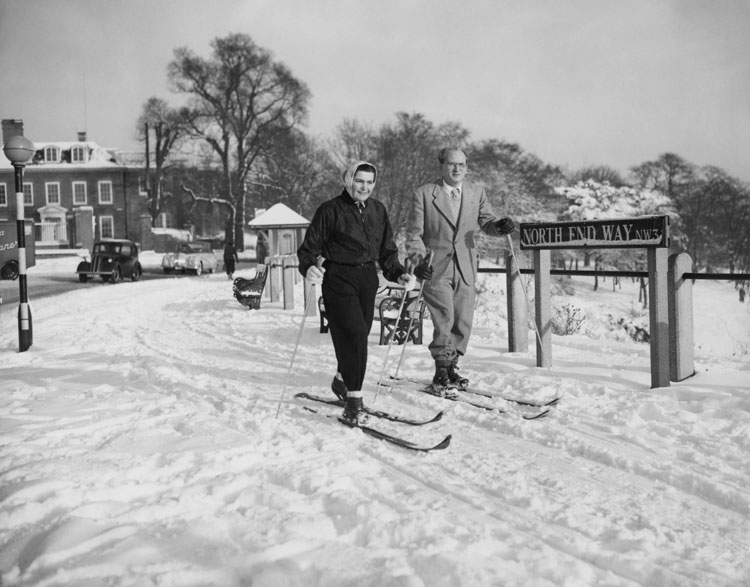 Before the Winter Games were established as their own separate event, the London Summer Games in 1908 actually included figure skating, making it the oldest official Olympic sport and the only event in which women could participate from the very beginning.
Before the Winter Games were established as their own separate event, the London Summer Games in 1908 actually included figure skating, making it the oldest official Olympic sport and the only event in which women could participate from the very beginning.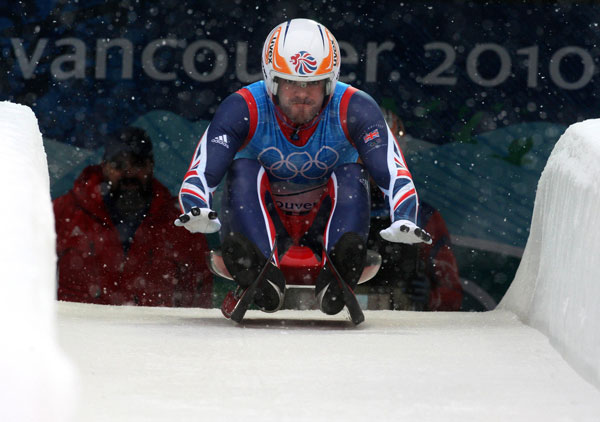 One of the oldest Olympic sports, Luge, which comes from the French word for sledge, sees athletes lying on their backs on a very small sled, and zipping down an icy track at around 140kmph – without brakes!
One of the oldest Olympic sports, Luge, which comes from the French word for sledge, sees athletes lying on their backs on a very small sled, and zipping down an icy track at around 140kmph – without brakes!